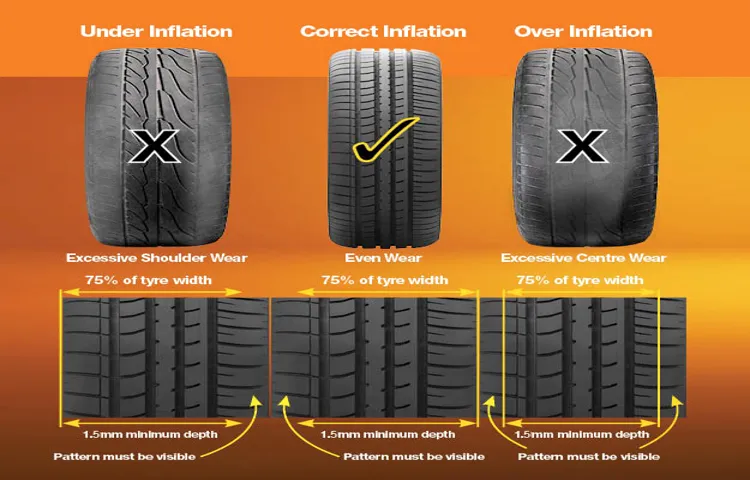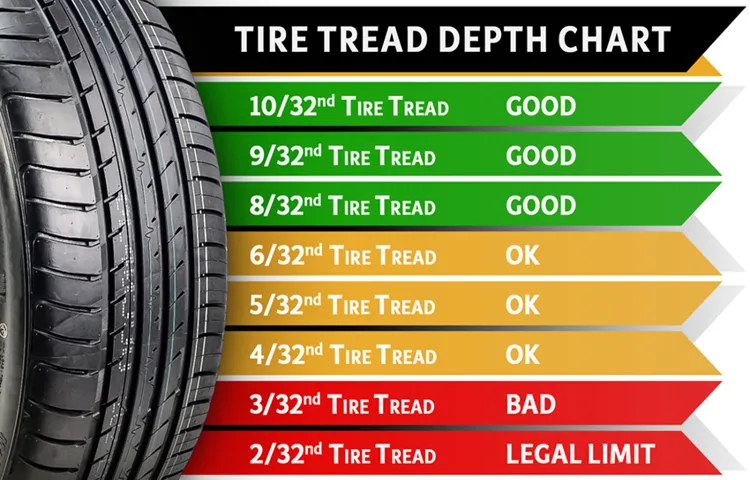Driving in Ohio can be quite an adventure especially if you are a first-time visitor or a new resident. The roads may be different, and the weather conditions may vary, but one thing that remains constant is the need for good tires and, more importantly, the minimum tire tread depth required by law. Ohio has specific regulations regarding the minimum required tire tread depth, and it’s crucial to know them before you hit the road.
Ensuring that your tires meet the minimum tread depth requirement can save you from potential accidents, traffic tickets, and hefty fines. As a responsible driver, you may be wondering, what is the minimum tire tread depth required in Ohio? And how can I ensure that my tires meet the required standards? In this blog post, we will answer these questions and provide you with everything you need to know about Ohio’s minimum required tire tread depth. We will also help you understand why having good tire tread depth is essential for your safety while on the road and offer some tips on how to maintain your car tires.
So, buckle up and let’s dive in!
Table of Contents
What is Tire Tread Depth?
Tire tread depth refers to the measurement of the grooves on the surface of your tires, which provide traction and help your car stay on the road. A minimum required tire tread depth is necessary to ensure that your tires are performing optimally and keeping you safe while driving. In Ohio, the minimum required tire tread depth is 2/32 of an inch.
This means that if your tire’s tread depth falls below this, it’s time to replace your tires. It’s important to regularly check your tire tread depth because having worn-out tires can be dangerous, particularly in wet or icy conditions. By maintaining proper tire tread depth, you can drive with confidence and stay safe on the road.
Definition and Importance of Tire Tread Depth for Safety
Tire tread depth refers to the depth of the grooves in a tire’s tread, which play a vital role in maintaining proper traction on the road. As a tire wears down over time, its tread depth decreases and can become dangerously low. In fact, the depth of your tire’s treads is one of the most important considerations for safety and performance.
This is because tire tread provides grip and channels water away from the tire, allowing it to maintain contact with the road surface. Without proper tread depth, your car is at risk of hydroplaning, skidding, and losing control on wet or slippery roads. In general, the minimum safe tread depth is considered to be 2/32 of an inch, but many experts recommend replacing tires when the tread depth reaches 4/32 of an inch to ensure maximum safety and performance.
Checking the tread depth regularly using a penny or a tire tread gauge is essential for maintaining your car’s safety and avoiding accidents on the road.

Tire Tread Depth Regulations in Ohio
If you’re driving on Ohio roads, it’s important to know what the minimum required tire tread depth is to avoid getting a ticket or causing an accident. The law states that your tires must have a minimum tread depth of 2/32 of an inch across the entire tire tread, including the edges. To determine if your tires meet this requirement, you can use a tire tread depth gauge or the penny test.
Simply place the penny upside down in the tread groove, and if you can see the top of Lincoln’s head, your tread is too worn and you should replace your tires. However, keep in mind that while 2/32 of an inch is the legal minimum, tire experts recommend replacing your tires when they reach 4/32 of an inch to ensure maximum safety and grip on the road.
Ohio’s Minimum Required Tire Tread Depth
In Ohio, there are regulations in place regarding the minimum required tire tread depth for vehicles driving on public roads. The law states that all tires on a vehicle must have a minimum tread depth of 2/32 of an inch. This applies to all types of vehicles, including cars, trucks, SUVs, and motorcycles.
The tread depth is measured by placing a penny upside down in the tire groove, and if the top of Lincoln’s head is visible, it means the tread is too shallow and needs to be replaced. It is important to maintain adequate tread depth to ensure proper traction and stability on wet or slippery roads. Driving with worn-out tires not only puts you at risk for accidents but also leads to costly fines and penalties, so make sure to regularly check your tire treads and replace them as needed to stay safe on the road.
Consequences of Driving with Tires Below the Minimum Tread Depth
Tire Tread Depth Regulations in Ohio are a crucial aspect of vehicle safety that many drivers tend to overlook. The state of Ohio enforces a minimum tire tread depth of 2/32 of an inch. Drivers who fail to comply with this regulation not only face a fine but also put themselves and others at risk of road accidents.
Tires with below the minimum tread depth cannot maintain proper traction on the road, which increases the risk of slipping, hydroplaning, and losing control of the vehicle. Furthermore, driving with tires below the minimum tread depth can lead to serious consequences such as blowouts, punctures, and tire failure, which can result in costly repairs and potential injuries. It’s essential that drivers in Ohio prioritize their safety and comply with the state’s tire tread depth regulations to avoid the devastating impact of accidents caused by unsafe driving.
Remember, investing in new tires is a small price to pay for the safety of yourself and others on the road.
How to Measure Tire Tread Depth?
When it comes to driving safely, maintaining the condition of your tires is crucial. In Ohio, the minimum required tire tread depth is 2/32 of an inch. This may seem like a small amount, but it can make a huge difference in your vehicle’s ability to grip the road.
To measure your tire tread depth, you can use a tire tread gauge, which is a simple tool that you can purchase at most automotive stores. Place the gauge into the groove between the tread blocks and read the measurement. Make sure to measure in multiple spots across the tire to get an accurate reading.
If you find that your tire tread depth is below the minimum requirement, it’s time to replace your tires.Keep in mind that maintaining proper tire pressure and rotation also play a role in your tire’s longevity and performance. By taking good care of your tires, you’ll not only comply with Ohio regulations, but you’ll also have better handling, braking, and overall safety on the road.
Recommended Methods to Check Tire Tread Depth
Tire Tread Depth When it comes to driving safely, having the right amount of tire tread depth is crucial. Over time, tread depth wears down, providing less grip on the road and increasing the risk of accidents. So, how do you measure tire tread depth? One simple and effective method is to use a penny.
Take the penny and insert it upside-down into the tread. If you can see the top of Lincoln’s head, then it’s time to replace the tire. Another method is to use a tire depth gauge, which gives more accurate results.
Simply insert the gauge into the tread and read the measurement. If your tread depth is consistently below 2/32 of an inch, it’s time for a replacement. It’s important to check your tire tread depth regularly to ensure maximum safety on the road.
DIY vs. Professional Inspection
When it comes to measuring tire tread depth, there are a few simple methods you can use whether you’re going the DIY route or opting for a professional inspection. One common method is to use a tread depth gauge, which can be purchased inexpensively. Simply insert the gauge into the tread groove and read the measurement.
Another DIY option is to use the penny test – if you can see Lincoln’s entire head when you place a penny upside down in the tread groove, it’s time for new tires. However, keep in mind that a professional inspection may be necessary if you suspect any issues with your tires or if you want a more comprehensive assessment of their condition. Ultimately, ensuring adequate tread depth is crucial for safe driving and avoiding accidents on the road.
When to Replace Tires?
If you’re wondering what the minimum required tire tread depth is in Ohio, it’s 2/32 of an inch. This is the legal tread depth limit for tires in the state, and if your tires have worn down below this point, they need to be replaced. However, it’s important to note that driving on tires with such low tread depth can be dangerous, especially in wet or snowy conditions.
To ensure maximum safety and performance, it’s recommended to replace your tires with new ones once they reach a tread depth of 4/32 of an inch. In addition to tread depth, it’s also important to regularly check your tires for signs of damage or wear, such as cracks, bulges, or uneven wear patterns. By taking proactive steps to maintain your tires, you can help ensure the safety of yourself and others on the road.
Factors to Consider When Deciding to Replace Tires
When it comes to deciding when to replace tires on your vehicle, there are several factors to consider. The first is age. Even if your tires look good, if they are over 5 years old, it’s recommended that you replace them.
Another thing to look for is tread depth. The tread should be at least 2/32 of an inch deep to ensure proper grip on the road. You can easily check this using a penny- simply insert it into the tread with Lincoln’s head facing down; if you can see the top of his head, it’s time for new tires.
Other factors to consider include any visible damage like cracks, bulges, or punctures, as well as your driving habits and the climate you live in. If you frequently drive on rough roads or in extreme temperatures, you may need to replace your tires more often. Bottom line: don’t wait until it’s too late to replace your tires.
It’s better to be safe than sorry, and investing in new tires will not only ensure your safety, but also improve the overall performance of your vehicle.
Signs That Indicate a Need for Tire Replacement
Knowing when to replace your tires is crucial for safe driving. One of the most apparent signs that indicate a need for tire replacement is when the tread depth reaches 2/32 of an inch. You can use a tread depth gauge to measure the depth of the tire grooves, but you can also use the penny test.
Insert a penny with Lincoln’s head facing down into the tread. If you can see the top of Lincoln’s head, it’s time for new tires. Another sign is sidewall bulges or cracks, indicating weak spots that could lead to a tire blowout.
Uneven tread wear, vibration, and pulling to one side while driving also signal the need for new tires. In general, tires should be replaced every six years, regardless of the amount of tread left. Remember, your tires are the only contact between your vehicle and the road, and keeping them in good condition is fundamental for your safety.
Conclusion
In Ohio, the minimum required tire tread depth is 2/32 of an inch. While that may seem like a small measurement, it’s important to remember that even a small amount of tread can make a big difference when it comes to safety on the road. So, whether you’re cruising down the highway or navigating your way through a snowstorm, make sure your tires are up to snuff and enjoy the ride with confidence.
“
FAQs
What is the legal minimum tread depth for tires in Ohio?
The legal minimum tread depth for tires in Ohio is 2/32 of an inch.
How can I measure my tire tread depth?
One way to measure your tire tread depth is to use a penny. Insert the penny into the tread with Lincoln’s head facing down. If the top of Lincoln’s head is visible, your tread depth is less than 2/32 of an inch and your tires may need to be replaced.
Is it safe to drive on tires with low tread depth?
No, it is not safe to drive on tires with low tread depth. It can lead to poor traction, hydroplaning, and increased risk of accidents.
How often should I check my tire tread depth?
You should check your tire tread depth at least once a month and before long road trips.
What are the consequences of driving with tires that have worn tread?
Driving with tires that have worn tread can result in a fine and even points on your driver’s license. More importantly, it poses a danger to you and other drivers on the road.
What is the best way to extend the life of my tires?
The best way to extend the life of your tires is to keep them properly inflated, rotate them regularly, and have them balanced and aligned as needed.
Can I still use my tires if they have uneven wear?
It is not recommended to use tires with uneven wear as it can affect their performance and compromise safety. Consult with a tire professional to determine if they need to be replaced.



